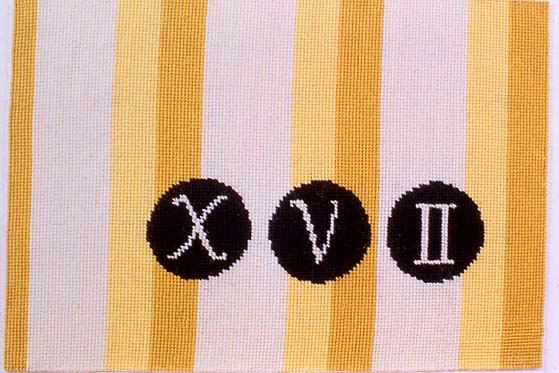View current page
...more recent posts
This page from the English department of a Japanese university strings together excerpts from science fiction novels and stories into a continuous single text. It reminds me of THE NAM, a phone-book thick transcription of dialogue from five Hollywood Vietnam movies by YBA (young British artist) Fiona Banner. The only two chunks of text I recognize are Heinlein's Stranger in a Strange Land and Cordwainer Smith's "A Planet Called Shayol" (any other attributions?). I wrote about the Smith story a while back and have cleaned up the excerpt from the Japanese page and posted it in the comments to that post. That is one f*ed up story.
The NY Times ran another in its endless series of chin-scratchers on "Internet Art" yesterday. The writer talked to a few of the players but couldn't reach any conclusions, so he opted for the annoying "on the one hand/on the other hand" format, while still trying to make it sound like some Rubicon had been crossed. Or retreated from. Or something. He mentions one noteworthy fact as evidence of the "death of Net Art"--that the Whitney included no internet section in the Biennial this year--but then doesn't talk to the current Biennial curators to ask why that decision was made. (Maybe it's just because the terminals never worked.) Instead, he tracks down the curator of the 2002 Biennial and gets some exquisite hot air on the subject.
Below is an annotated version of the article.
March 31, 2004
DIGITAL
Internet Art Survives, but the Boom Is Over
By BEN SISARIO
IT'S dead. It's thriving. It's everywhere and nowhere.
Like most things in the online world, the state of Internet art is subject to no small amount of exaggeration. During boom times, as art made with ones and zeroes entered Chelsea galleries [Postmasters] and blue-chip museums, the new form was seen as the wave of the future [by reporters and publicists]. But now, ask an artist or a gallery owner or a blogger about it and you are likely to get a groan [; ask an artist about it and you're likely to hear that no one calls it Net Art anymore; ask a blogger about it and he will mention a hundred wack things he's found lacking any institutional imprimatur.]

Bill Davenport, XVII, 1994, wool needlepoint (stitched by Olga Vannucci). My earlier discussion of Davenport is here, and more needlepoints from the series are here (click on thumbnails for enlarged views).
cuechamp recently posted a music mix titled "source code" [(76 min - 72MB - .mp3], consisting of the original songs--mostly from the '70s--that were subsequently, heavily mined for sampled drum breaks by hiphop and drum & bass producers. If you've listened to any music other than country (and maybe even that) for the last 25 years you will also recognize many of the piano stabs, vocal hooks, and random cowbells in these R&B, funk, and fusion classics (they were also very popular with house and garage producers). cuechamp doesn't layer or mash up the tunes: one song respectfully follows another in a nice flow that would also make it an excellent house party soundtrack. Here's the tracklist:
1. chase the devil - max romeo and the upsetters
2. amen, brother - the winstons
3. think about it - lyn collins
4. apache - incredible bongo band
5. ready or not - the delfonics
6. take me to the mardi gras - bob james
7. i'm gonna love you just a little more - barry white
8. shack up - banbarra
9. you can't hide from yourself - teddy pendergrass
10. scorpio - dennis coffey
11. fate - chaka khan
12. dance to the drummer's beat - herman kelly (I love this one -tm)
13. all this love that i'm giving - gwen mccrae
14. get out of my life woman - lee dorsey
15. far beyond - locksmith
16. ashley's roachclip - soulsearchers
17. i love you more - george duke
18. champ - the mohawks
19. praise you - camille yarbrough
20. funky drummer - james brown
It would be interesting to create graphs showing all the subsequent uses of sound bites from this "source code." If you sorted them by length you'd probably find the samples get longer in proportion to (1) the age of the track using the sample and/or (2) the economic strength of the samplee. This is because of an "invisible attractor" force in current creative endeavors called The Law. Early house and hiphop was made in the day before humorless poor sports like The Turtles started suing and winning cases for their precious string snippets. Nowadays the samplee becomes an involuntary creative partner in the new production, depending on the amount of lawyer fees he/she can afford (or recoup on contingency). Such issues are discussed in Lawrence Lessig's new freeware book, also linked to on cuechamp's page.
Here's a relevant quote pulled not from Lessig's .PDF but from a NY Times article about the Danger Mouse Grey Tuesday protest, before the article disappeared into the Times' proprietary vault:
Jonathan Zittrain, a director of the Berkman Center for Internet and Society at Harvard Law School, said the issue is indeed a gray one. "As a matter of pure legal doctrine, the...protest is breaking the law, end of story," Mr. Zittrain said. "But copyright law was written with a particular form of industry in mind. The flourishing of information technology gives amateurs and home-recording artists powerful tools to build and share interesting, transformative, and socially valuable art drawn from pieces of popular culture. There's no place to plug such an important cultural sea change into the current legal regime." (emphasis added)
